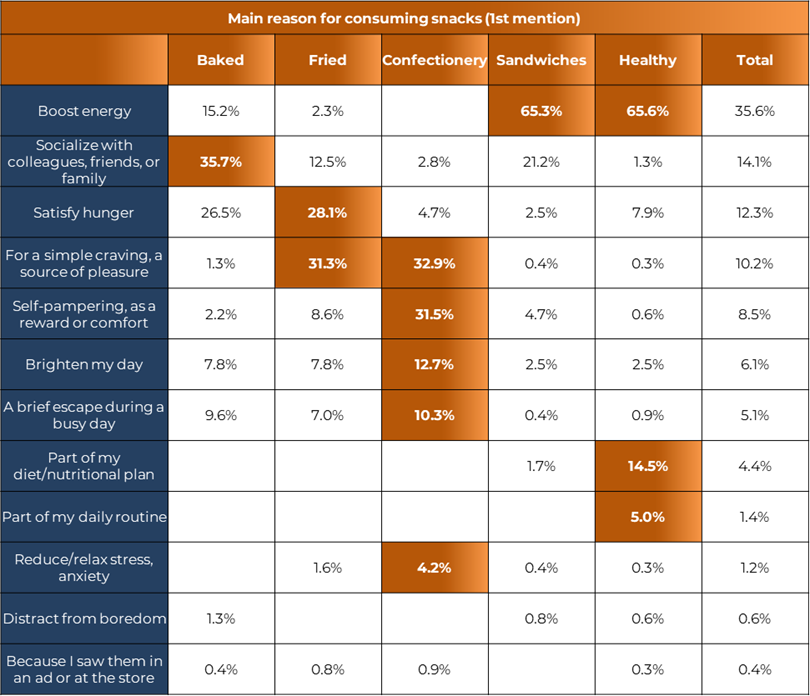
Author: José Ignacio Domínguez
Methodology and Sample in Mexico
We studied 1,028 Mexicans across the country to understand their habits, tastes, preferences, and attitudes toward snack consumption—that is, what they eat between the main meals of the day.
This is a quantitative study conducted through online surveys with individuals aged 18 to 80 years.
Natural distribution was maintained in terms of age, economic levels, and geographic balance.
Meal Times
Most Mexicans have two or three full meals a day, while two small minorities either have only one or up to four.
Table 1: Meal Schedule

The number of full meals Mexicans consume varies inversely with age: the younger they are, the more full meals they eat per day.
Table 2 (Number of Meals by Age)

Frequency and Reasons for Snack Consumption
Those who have three or four full meals tend to consume snacks very rarely or only on some days.
Meanwhile, those who have only one or two full meals stand out for consuming snacks every day.
The main reason for consuming snacks among those who eat only one or two full meals is to satisfy hunger, preferring both oil-free and regular chips, as well as prepared snacks.
In contrast, those who have three full meals a day snack mainly out of simple cravings, favoring cookies, nuts, and seeds. (Table 5)
Table 5: Consumption Frequency by Number of Meals

Table 6: Reason for Consumption by Number of Meals

Types of Snacks and Preferences
- Fried: Chips, pretzels fried in oil
- Sandwiches: Small sandwiches, cheese, and ham rolls
- Baked: Popcorn, chips, pretzels baked without oil
- Confections: Cookies, pastries with or without filling, candies or sweets, chocolate
- Healthy: Yogurt alone or with fruits or cereals, cheese alone or combined with fruits, fresh fruits and vegetables, granola or cereal bars
The reasons for consuming each type of snack are clearly different
- Baked snacks and Sandwiches are consumed to satisfy hunger
- Confections are consumed for a simple craving, as a source of pleasure, and for self-indulgence, like a reward or comfort
- Fried snacks are consumed to socialize with colleagues, friends, or family
- Healthy snacks are consumed to increase energy
Table 7: Most Frequently Consumed Snack by Category

The types of snacks are also associated with different reasons for consumption:
Table 8: Reason for Snack Consumption by Category

Consumer Segments
Four consumer segments were identified based on their motivations:
Table 9: Reason for Consumption by consumer segment

A Comparison with the USA
The relationship between consumer segments and types of snacks differs between both countries.
Graph 1: Consumer segments by type of snack in each country

Graph 2: Consumer segments by type of snack in each country

Methodology and sample in the USA:
We studied 1,124 Americans across the country to understand their habits, tastes, preferences, and attitudes towards snack consumption; that is, what they consume between the main meals of the day.
This is a quantitative study conducted through online surveys with people aged 18 to 80 years.
Natural drops were maintained regarding age, economic levels, and a balance between geographical areas was kept.
Time of meals
Most Americans have two or three full meals during the day, while three small minorities have only one, or up to four or five.
In the USA, the typical times for full meals are in the morning (5:30 to 6:00 AM), at midday (1:00 PM), and in the evening (from 8:30 PM to 9:00 PM).
Table 10: Meal Schedule

The number of full meals Americans have: Varies inversely with age
The younger they are, the more full meals they eat per day, the more they eat.
Table 11 (Number of Meals by Age)

It ranges from 1 to 2 in the lower socioeconomic level (SEL) and from 3 to 4 in the middle SEL; the upper SEL stands out for having 2 full meals.
Table 12 (Number of Meals by Socioeconomic Level)

It is higher among singles and lower among adults living alone (separated, divorced, widowed).
Table 13 (Number of Meals by Marital Status)

It is higher among Whites and lower among African Americans and Hispanics.
Table 14 (Number of meals by ethnicity)

Frequency and Reasons for Snack Consumption
Those who have 3 or 4 full meals stand out for consuming snacks very rarely or only on some days, frequently; whereas those who have 1 or 2 full meals stand out for consuming snacks every day.
The main reasons for consuming snacks among those who only have 1 or 2 full meals are to Satisfy Hunger and for a simple craving; among those who have 4 or more meals, the reasons are to Boost Energy and Socialize with colleagues, friends, or family.
Table 15 (Snack Consumption Frequency by Number of Meals)

Table 16 (Reason for consumption by number of meals)

Types of Snacks and Preferences
A snack grouping based on consumption frequency allows them to be categorized into 5 types :
- Sandwiches: Small sandwiches, cheese, and ham rolls
- Healthy: Chocolate, nuts and seeds, cheese alone or combined with fruits, fresh fruits and vegetables, yogurt alone or with fruits or cereals, granola or cereal bars
- Baked: Popcorn, chips, baked pretzels without oil
- Fried: Chips, fried pretzels in oil
- Confections: Sweets or candies, pastries with or without filling, cookies
The reasons for consuming each type of snack are clearly distinct :
- Sandwiches are consumed to boost energy.
- Healthy snacks are consumed to boost energy, as part of a diet or nutritional regimen, or as part of a daily routine.
- Baked snacks are consumed to socialize with colleagues, friends, or family.
- Fried snacks are consumed for a simple craving, as a source of pleasure, or to satisfy hunger.
- Confections are consumed for a simple craving, as a source of pleasure, self-indulgence, as a reward or comfort, to brighten the day, or for a brief escape during a busy day.
Table 17 (Most Frequent Snacks by Snack Type)

The types of snacks are also associated with different reasons for consumption:
Table 18 (Reason for Consumption by Snack Type)

Consumer Segments
Four consumer segments are identified based on their motivations:
Table 19 (Reason for Consumption by Consumption Segment)

A Comparison with Mexico
The relationship between Consumption Segments and Snack Types is different in both countries.
Graph 7 (Consumption Segments by Snack Types in Each Country)

Graph 8 (Consumption Segments by Snack Types in Mexico and the USA)

At Cuantía, we strive to continue conducting opinion studies that offer a global perspective on topics of interest. Are you interested in participating? Send us an email through our contact form or on our social media and let us know the topics you’d like us to research.
